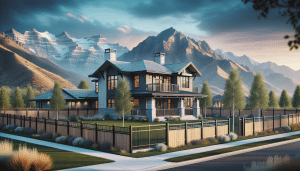Welcome to the Logan Fence Company blog, where we understand that selecting the right fence height is a crucial decision when it comes to your property’s security, privacy, and aesthetics. In this informative guide, we’ll help you navigate the factors that influence fence height choices, ensuring that your fence serves its purpose while enhancing the overall appeal of your home.
Your fence is not just a physical boundary; it also defines the look and feel of your property. This guide will help you make informed decisions about choosing the right fence height for your specific needs.
Contents
Understanding Your Goals
Before determining the ideal fence height, consider your primary goals. Are you seeking privacy, security, safety, or aesthetics? Understanding your objectives will guide your decision-making process.
Legal Considerations
It’s essential to be aware of local regulations and zoning codes that govern fence heights in your area. These regulations can vary significantly, so check with your local government or homeowner’s association to ensure compliance.
Choosing the Appropriate Fence Height
The appropriate fence height depends on the specific purpose and location of the fence:
Front Yard Fences
Front yard fences are typically lower than backyard fences to maintain an open and welcoming appearance. Heights often range from 3 to 4 feet, although some areas may allow up to 6 feet.
Backyard Fences
Backyard fence heights vary based on your goals. Common heights for backyard fences range from 6 to 8 feet, providing privacy and security.
Pool Fences
Pool safety regulations may mandate a specific fence height to prevent unauthorized access. Check your local pool safety regulations for guidance.
Privacy Fences
Privacy fences are often taller, ranging from 6 to 8 feet or higher, to block views and create a secluded outdoor space.
Aesthetic Impact
Consider the aesthetic impact of your fence height. A fence that complements your home’s architecture and landscaping can enhance curb appeal and property value.
Maintenance and Longevity
Keep in mind that taller fences may require more maintenance, such as painting or staining. Choose materials that are suitable for the local climate to ensure longevity.
FAQs About Fence Height
Are there height restrictions for residential fences?
Yes, height restrictions for residential fences are common and vary by location. Check local regulations for specific guidelines.
How do I measure the height of a fence?
Measure from the ground level to the highest point on the fence, which is typically the top of the posts or the tallest part of the fence.
Can I vary the height of my fence?
Some areas allow variation in fence height, especially for decorative elements or slopes in the landscape. Check local regulations for guidance.
Do corner lots have different height regulations?
In some areas, corner lots may have stricter height regulations to ensure visibility for drivers. Check local regulations for specific rules.
Should I consult with my neighbors about fence height?
It’s a good practice to discuss your fence plans with neighbors, especially if the fence will impact their property or views. Open communication can prevent conflicts.
Conclusion: Finding the Right Balance
Choosing the right fence height involves a balance between your goals, local regulations, aesthetics, and maintenance considerations. Logan Fence Company is here to assist you in making the best decision for your property. If you have questions or need further guidance, don’t hesitate to contact us. Let’s find the perfect fence height that meets your needs and enhances your property.




